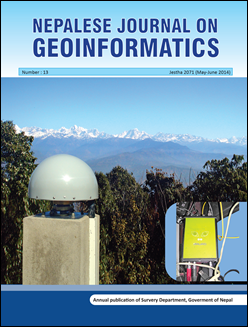Multihazard Mapping of Banepa and Panauti Municipalities
DOI:
https://doi.org/10.3126/njg.v13i0.16934Keywords:
Earthquake, Flood, Landslide, Industry, Hazard assessment, Composite multi-hazardAbstract
A combination of rough topography, steep slopes, active tectonic and seismic process and intense impact of monsoon rain has made the fragile environment of Nepal vulnerable to a variety of natural hazards. Most frequent hazards are floods, landslides, epidemics, fires, earthquake and other hydro-meteorological disasters, causing heavy loss of human lives as well as economic loss including housing and infrastructures (MDRIP, 2009). Hence, hazard assessments are the need of the hour. They help district and regional decision makers, policy makers and development agencies prepare disaster risk reduction plans. The chosen study area was Banepa and Panauti municipality. Separate hazard assessments have been performed for four hazards, namely, earthquake, flood, landslide and industrial hazards.
Earthquake hazard zone maps have been made following the Probabilistic Seismic Hazard Assessment (PSHA) approach for 500 year return period to produce seismic intensity distribution maps in the form of Modified Mercalli Intensity (MMI) maps using Trifunac and Brady formula. Flood inundation maps have been made using HEC-RAS and HEC-GeoRAS extension for ArcGIS for return periods of 2, 10 and 500 of Chandeswori and Punyamata rivers. Landslide hazard susceptibility map has been made using the Stability Index Mapping (SINMAP) extension for ArcGIS that uses an infinite-slope equation accurate for debris flows. Industrial hazard maps that depict the vicinity that falls within various ranges of danger in the event of different industrial hazards like fire, Vapor Cloud Explosion (VCE) and Boiling Liquid Expanding Vapor Explosion (BLEVE) have been prepared as well. Finally, a composite multi hazard map has been prepared by combining all the four hazards.
Nepalese Journal on Geoinformatics -13, 2014, Page: 25-31




